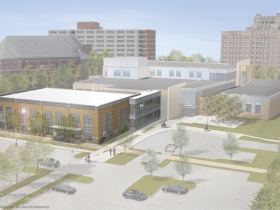Why We Lag in Kids’ Dental Care
Study says WI is 2nd-worst state in America. It’s not true, but there are ways we could improve.
The headlines from the Milwaukee Journal Sentinel and Associated Press blared the news that Wisconsin ranks second-worst in America for poor kids’ dental care, according to a new report. The media swallowed the study whole, but it’s quite misleading. While Wisconsin could always do better, we’re nowhere near as bad as the research suggests.
The report was by the Pew Charitable Trusts, and seeks to dramatize the huge number of children who aren’t getting dental care. It estimated that 14 million children enrolled in Medicaid did not receive any dental service in 2011.
The report found that 71.5 percent of Medicaid-enrolled children in Wisconsin did not visit a dentist in 2011, which was better only than Florida, where the figure was 75.5 percent.
So, for those Democrats who carped about what Gov. Jim Doyle ever accomplished, he greatly expanded Medicaid and BadgerCare. You might call him the Health Care Governor. In just nine months, between December 2007 and September 2008, 42,000 children were added to BadgerCare. William Lobb, Dean of Marquette University’s School of Dentistry, says that by 2010, the number of children in Wisconsin eligible for Badger Care or Medicaid rose from just under 63,000 to more than 166,000, which meant far more children were eligible for dental care.
Back in 2005, 70 percent of Wisconsin children eligible for dental care under Medicaid were not receiving it, as a news story noted. As the Pew Study shows, the percentage was about the same in 2011 for Wisconsin, but more than twice as many children were eligible for coverage by then.
If the Pew study’s ranking of the states is questionable, its general conclusion that many children eligible for Medicaid dental coverage aren’t getting it is undoubtedly true. The reasons are several.
For starters, dentists complain that the reimbursement rates are too low. Dr. Michael Costello, a dentist with an office in Downtown Milwaukee, says when he started practicing 32 years ago, Medicaid covered 80 percent of the cost of providing the care. Today, he says it’s down to less than half of that. It pays for his overhead and maybe half of his staff salaries, but leaves him underwriting the rest. “You can only do so much charity,” he says.
Stephanie Harrison, Executive Director of the Wisconsin Primary Health Care Association, agrees that reimbursement rates can be a problem. “There really is a wide variety among the states in terms of the rates at which they reimburse dentists for Medicaid coverage.”
The Pew study deplored “the relatively small number of dentists who participate in Medicaid, adding that “Dentists cite multiple factors for not participating in Medicaid; chief among them are low reimbursement rates and burdensome administrative procedures.”
But Harrison says another issue is shortages of dentists that can prevent access to care.“There are some areas in Northern Wisconsin where there may be only one or two dentists per county.” She adds that there are “still a large number of people in Milwaukee” who also lack care.
The Pew study also cited this shortage as a factor. It measured the distributions of dentists within states and found Mississippi ranked the worst, with 36 percent of the population under-served by dentists. In Wisconsin, just 9.1 percent of the population was under-served, which gave this state a better ranking than 28 states and the District of Columbia.
However, Wisconsin’s shortfall could increase, as the Pew study ranked it 7th among states in percentage of dentists (about 45 percent) nearing retirement. “I think that’s going to be a big issue, especially in northern counties,” says Harrison.

Marquette University School of Dentistry Expansion Rendering. Rendering from Marquette University.
This fall the MU School of Dentistry expects to open its new, $16 million, 45,000-square-foot addition, which will enable the school to increase its class size to 100 students, up from 80 now. Lobb estimates that about 80 percent of the Wisconsin residents and 28 percent of the non-resident students practice in the state immediately after graduating from MU. Even given some retirements by older dentists, “I think over time there will be a net gain in dentists in Wisconsin,” he says.
The lack of dental coverage for low-income children can actually end up costing states more in the low run, the Pew study notes, because “children and adults are more likely to end up in hospital emergency rooms with serious dental conditions that could have been prevented. In 2009, more than 830,000 Americans were treated in ERs for toothaches or other preventable dental problems. For many low-income children, emergency rooms are the only option because their families cannot find a dentist who practices in their area or accepts Medicaid.” The result, the study notes: “These hospital visits exacerbate states’ financial burdens.”
The study suggested that dental check-ups, teeth cleaning and preventive care could be handled more cheaply by dental hygienists, and that there should be more training of these professionals. “By playing a role similar to nurse-practitioners in the medical field,” they could “help bring care to millions of people who live where dentists are scarce. Midlevel dental professionals also can make it financially feasible—and in some cases profitable—for private-practice dentists to serve more low-income patients. Because their salaries are significantly lower than dentists’, alternative providers, who operate under the supervision of a dentist, also offer states a cost-effective approach to address the unmet need for care.”
The study note that this type of practitioner may not be common in the U.S., but “dental therapists already offer routine preventive and restorative care (such as filling cavities) in more than 50 countries. Research both internationally and in the United States finds that these dental professionals provide quality, safe care.”
That sort of training could potentially be provided by a range of institutions, from voc-tech schools like Milwaukee Area Technical College to universities. And it could lower the cost of both privately and publicly-financed dental care.
Short Takes
-Cities on rebound: A review of recent statistics shows all population growth of last two years in Wisconsin was in urban areas.
-Are Scott Walker’s policies the reason Wisconsin has trailed the nation in job growth in 21 of the last 23 months?
-Did the city need to spend $350,000 on robotic intersection messages that tell us to “wait wait wait” for the light to turn green? Join the discussion.
Murphy's Law
-
Is Legislature Biased Against Working Class?
 Apr 4th, 2024 by Bruce Murphy
Apr 4th, 2024 by Bruce Murphy
-
Associated Press Will Decline in Wisconsin
 Mar 27th, 2024 by Bruce Murphy
Mar 27th, 2024 by Bruce Murphy
-
City Attorney Race Is Vitally Important
 Mar 25th, 2024 by Bruce Murphy
Mar 25th, 2024 by Bruce Murphy

















It’s a thorny issue close to my heart: I have a sister with four girls on the Medicaid program (in the past year, she gave up on getting child support from the fathers and got a job that pays around $25k) and only a couple of my nieces have ever seen a dentist. Why? There are only four dentists within a 30-mile range that accept the form of payment, and none of them have any room for new clients.
There are too few dentists who will accept patients on any sort of government assistance, and too few patients who can travel far enough (even the MU School would be a 20- mile trip) to find someone who will help.
I also think about what my own dentist charges for any kind of work, and I have great dental insurance. I know our teeth are a surprisingly delicate thing and the work is actually medical, but I also wonder about the pricing structure for any office medical procedure (like an EKG) that I have done. So the dentists who say “there is only so much charity work I can do” need to check themselves and verify that is true.
We may not be second-worst in the nation, but it sure feels that way sometimes. At least we’re “The Brainiest” city (thanks, Richard Florida!)–maybe we can use these huge craniums to come up with some innovative solutions before our poor population can only eat cottage bread and applesauce.
Wow……. this is the first article on dental care I have ever read that did not mention flossing.
Seriously, why dental care is not part of “health care” is beyond me.
Re Brian’s comment regarding Richard Florida’s chart that puts Milwaukee Metro area on of the brainy list. Maybe this is a good time to point that these sorts of lists (or studies as we like to call them) are just pseudo-thinking. According to Florida, who quotes Edward Glaesner, that means that Milwaukee should be growing into an economic powerhouse. Does anyone see any see any evidence of that?
I agree that the measure used, as it is not consistent across states, is flawed. However, other research which has examined the issue found similar results using more comparable measures. For example, a 2011/12 study of the Data Resource Center for Child & Adolescent Health found Wisconsin ranked 2nd worst (49 out of 50) among states in the number of children at or below the federal poverty level (thereby standardizing the measurement) who had no preventive dental visits within the past 12 months, behind only Florida. Interestingly, for the most well-off children, those at or above 4 times poverty level, Wisconsin scored 2nd BEST, behind only Hawaii! Obviously, the resources are there, they are just not accessible to everyone.
See for yourself at http://bit.ly/PoorKidsTeeth
Problem is simple, inner city parents are not taking kids to dentist.
http://www.jsonline.com/features/health/mission-of-mercy-brings-dental-care-to-those-in-need-b9943926z1-213603651.html
Offer it and they will come.
As a practicing dentist for 30 years in Milwaukee I find this disturbing. It is true that reimbursement rates are quite low here in Wisconsin. In comparison Illinois’s healthy smiles program pays a lot more and most dentists take the program. But, as in my practice, there are ways to see Medicaid patients and still ensure financial viability. There just has to be a good mix of private insurance and medicaid patients and you are fine. I think as dentists we owe it to the community to provide those less fortunate with basic preventive dental care. That being said, I tend to see medicaid patients and children only in emergencies they simply don’t come for preventive measures, lots of canceled appointments, even though they are covered and I am happy to see them. Somehow the system is broken. Look to Illinois and California’s healthy smiles program. Its better to pay for preventive care for children than those problems becoming major when they are older.
If a dentist starts their own practice they face a variety of challenges that make accepting Medicaid patients difficult. Consider the following:
– It’s likely they will have about $300,000 or so in student loan debt.
– If they do a start-up practice, it will cost them between $400,000 to $500,000 to outfit a 4 op office
– The insurances they take will be taking at least 15% off their usual and customary fees to begin with
– It’s not inexpensive to run an office. Dental supplies run about 7% of revenues. Lab will be another 6% or so. Occupancy costs, especially in a metropolitan area will run at 10%. Then you have staff costs eating up about another 30% all in and contrary to what many think there are very good jobs in dental. A good hygienist will make $35+ per hour. A dental assistant with some experience will be at $18-$20 per hour.
So taking a 50% haircut on fees doesn’t leave much of anything left given that the average office runs at about 63% overhead. A 50% write-off means the typical dentist can’t cover overhead, so they don’y need to “check” themselves as another poster suggested.
You can make a medicaid only practice work, but a doc would have to decide that’s all they want to to. You’d run a bare bones type of office and survive on volume. That’s harder to do in a Metropolitan area because most dentists will have a smaller physical plant meaning they can’t take advantage of efficiencies like double booking.
To fix this is actually pretty simple. Medicaid just has to give the Marshfield Clinic deal (a much higher reimbursement rate) to a few larger clinics and it would be much easier to get access.